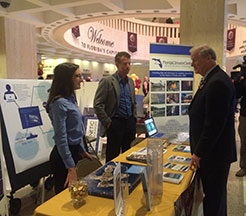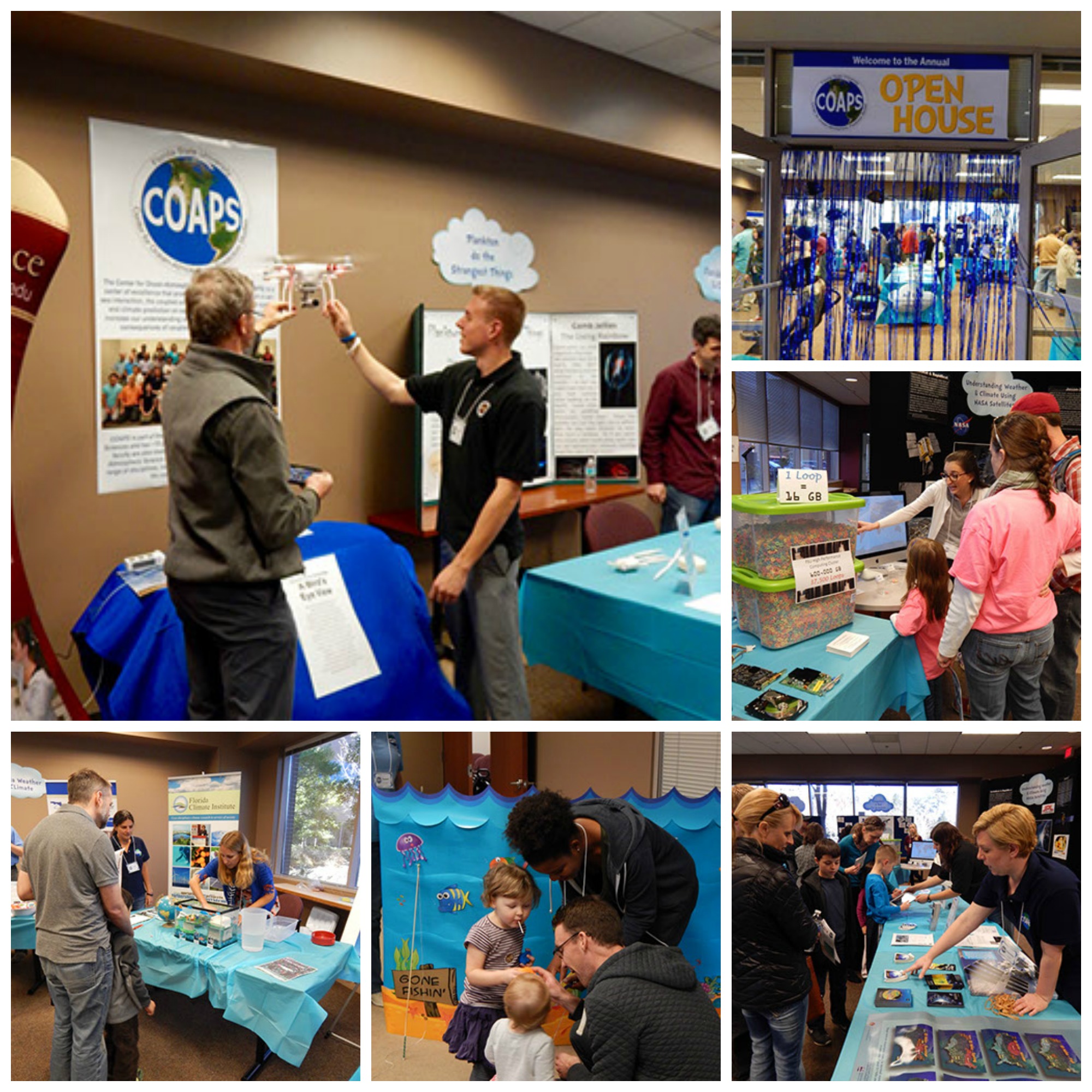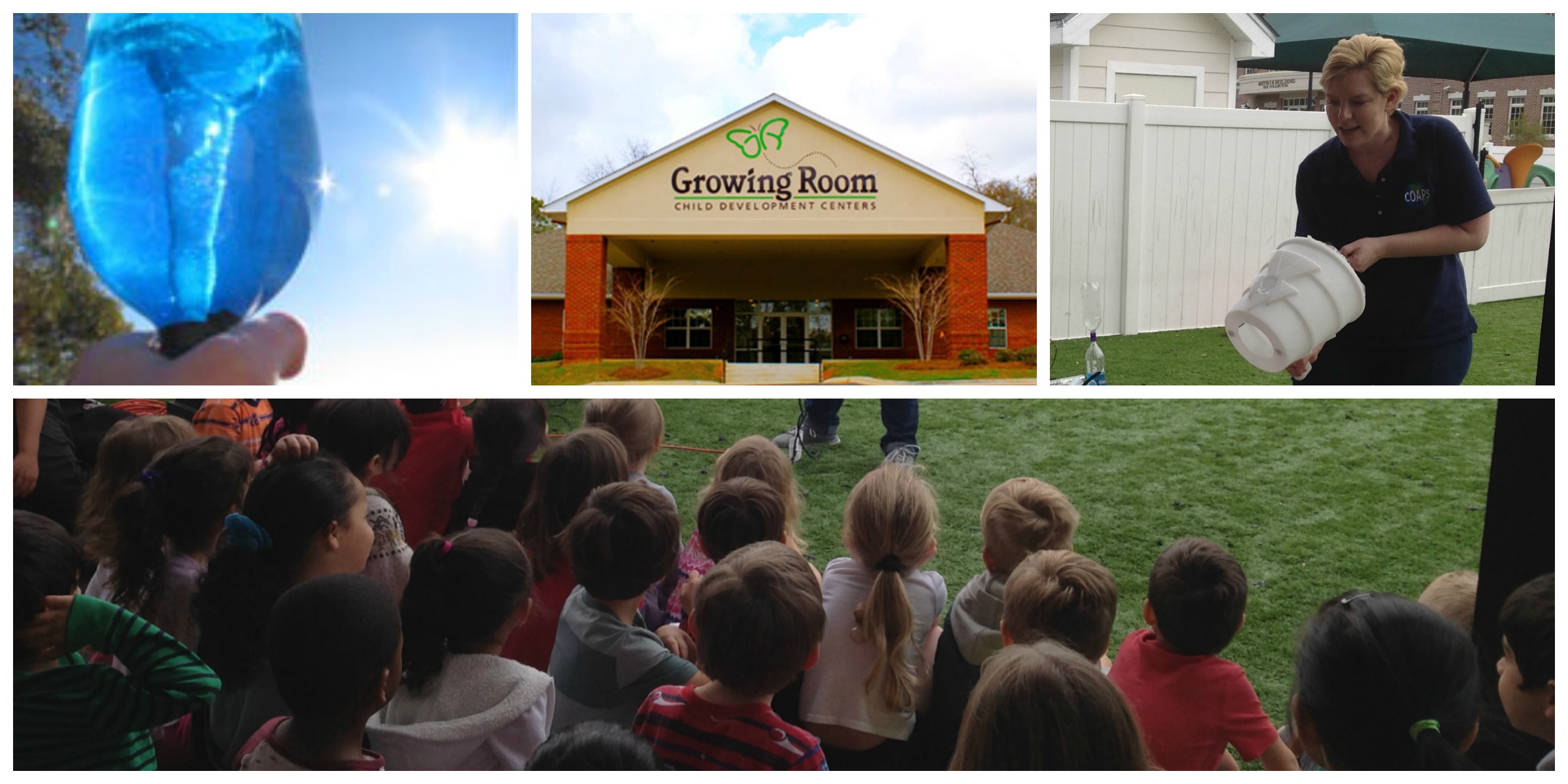Longer-Term Weather and Environmental Forecasts Will Provide Enormous Benefit with More Research and Sustained Investment, New Report Says
Source: The National Academies of Sciences, Engineering, and Medicine
 Weather and environmental forecasts made several weeks to months in advance can someday be as widely used and essential as current predictions of tomorrow's weather are, but first more research and sustained investment are needed, says a new report from the National Academies of Sciences, Engineering, and Medicine. COAPS director Dr. Eric Chassignet is a member of the committee that conducted the study and wrote the report. The committee developed a research agenda, outlining strategies to address the scientific and capability gaps that currently limit the accuracy and usefulness of long-term weather and ocean predictions. Weather and environmental forecasts made several weeks to months in advance can someday be as widely used and essential as current predictions of tomorrow's weather are, but first more research and sustained investment are needed, says a new report from the National Academies of Sciences, Engineering, and Medicine. COAPS director Dr. Eric Chassignet is a member of the committee that conducted the study and wrote the report. The committee developed a research agenda, outlining strategies to address the scientific and capability gaps that currently limit the accuracy and usefulness of long-term weather and ocean predictions.
Extending short-term forecasts to predict Earth system conditions -- conditions in the atmosphere, ocean, or land surface -- two weeks to 12 months into the future will help decision makers, such as local officials, farmers, military officers, or water resource managers, plan ahead and save lives, protect property, and increase economic vitality. For example, naval and commercial shipping routes could be better planned to avoid hazards or take advantage of favorable conditions predicted for the weeks ahead.
The report outlines a 10-year agenda with research strategies to make seasonal and subseasonal forecasts more accurate and relevant. The report notes these research strategies will all require advances in the U.S. computational infrastructure to support subseasonal to seasonal forecasting and a national plan and investment strategy for the future. The sheer volume of observational data, data assimilation steps, and model output involved in this forecasting challenges the limits of current cyber-infrastructure. This growing subseasonal to seasonal field also needs a workforce able to cross traditional disciplinary boundaries within the Earth sciences, between computing and physical science fields, and to bridge the divide between researchers and decision makers. Read the four-page report brief.
Pre-publication copies of Next Generation Earth System Prediction: Strategies for Subseasonal to Seasonal Forecasts are available from the National Academies Press on the Internet at http://www.nap.edu
|
SAMOS program helps improve weather predictions
Source: NOAA Climate Program Office (CPO)
Every day, ships, buoys, and coastal platforms take millions of surface temperature, pressure, humidity, and wind measurements from across the ocean. Although these measurements help meteorologists predict the weather each day, they also play a key role in calibrating measurements from satellites orbiting the Earth.
Traditionally, marine weather measurements from ships are only taken once an hour. This hourly sampling proved to be inadequate to calibrate satellite sensors--particularly those measuring winds over the ocean because the winds can change in a matter of minutes at any given location. To solve this problem, in 2003, a group of scientists designed a program to collect marine weather observations once a minute from oceanographic research vessels. Because satellites take many more readings than ships or other observation platforms, increasing the number of measurements on ships allowed scientists to better match ship and satellite observations in space and time. This helped improve the methods used by satellites to measure surface weather conditions. These calibrated satellite data are, in turn, used by the computer models to improve daily weather forecasts.
This program is known as the Shipboard Automated Meteorological and Oceanographic System (SAMOS) and it is led by the Center for Ocean-Atmospheric Prediction Studies at the Florida State University (FSU). Read the full article.
|
|
Activities & Achievements
|
 DOMS website launched DOMS website launched
COAPS recently launched a website for the Distributed Oceanographic Match-up Service (DOMS), a web-accessible service tool that will reconcile satellite and in situ datasets in support of NASA's Earth Science mission. When complete, DOMS will provide a mechanism for users to input a series of geospatial references for satellite observations (e.g., location, date, and time) and receive the in-situ observations that are "matched" to the satellite data within selectable time and space tolerances of the satellite observations. The inverse of inputting in situ geospatial data (e.g., positions of moorings, floats, or ships) and returning corresponding satellite observations will also be supported. The DOMS prototype includes several characteristic in situ and satellite observation datasets. For the in situ data, the focus will be surface marine observations from the International Comprehensive Ocean-Atmosphere Data Set (ICOADS), the Shipboard Automated Meteorological and Oceanographic System Initiative (SAMOS), and the Salinity Processes in the Upper Ocean Regional Study (SPURS). Satellite products will include JPL QuikSCAT winds, the Aquarius orbital/swath dataset, and the high-resolution gridded MUR-SST product. Importantly, although DOMS will be established with these selected datasets, it will be readily extendable to other in situ and satellite collections, which could support additional science disciplines. The DOMS development team includes partners from FSU-COAPS, the National Center for Atmospheric Research, and NASA's Jet Propulsion Laboratory.
|
COAPS scientists to develop a quasi-real-time weather/climate prediction system for Korean research institute
 Drs. Dong-wook (DW) Shin and Steven Cocke have been enlisted by the Korea Polar Research Institute (KOPRI) to develop a prototype of a quasi-real time weather/climate prediction system for data collection, model initialization, forecast, evaluation, and visualization in a web environment. The prototype system will be of tremendous value to the weather/climate prediction society in Korea and lead to improve weather/climate forecasts which will allow all citizens to make better decisions in the short-, medium- and possibly long-term future. It will also be an excellent tool for students to understand the overall modeling process system.
COAPS featured at Innovation Park's "TechTopics" luncheon
 COAPS Director Dr. Eric Chassignet, State Climatologist Dr. David Zierden, and COAPS alum Dr. Mark Powell were featured speakers at the March 2016 TechTopics luncheon in Tallahassee, FL. The TechTopics Series (formerly known as Industry Sector Roundtables), focuses on the unique research assets and commercialization opportunities specific to the city's Innovation Park. Dr. Chassignet gave an overview of the research being conducted by COAPS researchers, while Dr. Zierden presented on the 2016 Super El Nino and how it impacts climate and extreme weather in Florida. Dr. Powell gave an update on the work being conducted by HWind Scientific, a real-time hurricane data company. COAPS Director Dr. Eric Chassignet, State Climatologist Dr. David Zierden, and COAPS alum Dr. Mark Powell were featured speakers at the March 2016 TechTopics luncheon in Tallahassee, FL. The TechTopics Series (formerly known as Industry Sector Roundtables), focuses on the unique research assets and commercialization opportunities specific to the city's Innovation Park. Dr. Chassignet gave an overview of the research being conducted by COAPS researchers, while Dr. Zierden presented on the 2016 Super El Nino and how it impacts climate and extreme weather in Florida. Dr. Powell gave an update on the work being conducted by HWind Scientific, a real-time hurricane data company.
|
|
 The annual FSU Day at the Capitol, held this year on February 2, was an opportunity to celebrate the university's recent successes and contributions. Inside the Capitol, FSU showcased its academic excellence with information booths representing the university's academic programs and research centers, including COAPS.
The annual FSU Day at the Capitol, held this year on February 2, was an opportunity to celebrate the university's recent successes and contributions. Inside the Capitol, FSU showcased its academic excellence with information booths representing the university's academic programs and research centers, including COAPS.
|
 |
|  |
R. Weihs
|
Rachel Weihs, (Ph.D. student, Meteorology) was awarded a $500 travel grant through the Ermine M. Owenby Jr. Fund to Promote Excellence. The Fund's purpose is to provide support for women enrolled in any of the graduate programs in the College of Arts and Sciences so that they might present papers at professional meetings Weihs will be using the award to attend the International Ocean Vector Winds Science Team Meeting in Sapporo, Japan on May 17-19, 2016.
|
|
COAPS showcases science (and fun!) at annual open house
 COAPS' annual open house is designed to stimulate public knowledge about science, particularly the kind of science being conducted at COAPS. This year's open house was attended by nearly 800 visitors and featured something for everyone... hands-on science fun, self-guided tours, and the chance to meet and interact with our scientists. Attendees learned how drones are used to observe the earth, about rising seas, marine data, and how COAPS researchers are modelling the ocean and atmosphere. They were able to drive an underwater robot, and to see and touch live sea creatures (thanks to our colleagues in the FSU Biology Department's Sea-to-See program).
|
|
"W" is for weather

Students at Tallahassee's Growing Room Learning Center have been learning about weather. So they invited COAPS' Danielle Groenen, PhD student in Meteorology, to visit the center on March 29 and share some fun with science! Ms. Groenen demonstrated the power of wind, made a cloud in a bottle, and everyone had fun doing the Water Cycle Boogie.
|
Prospective grad students tour COAPS during FSU visit
Prospective graduate students from around the country visited COAPS on March 18 to learn more about the Florida State University meteorology program and research being conducted at COAPS. FSU graduate student representatives Heather Holbach, Rachel Weihs, and John Steffen organized and conducted the tour in cooperation with the Department of Earth Ocean and Atmospheric Sciences (EOAS). The visitors were welcomed by COAPS Director Eric Chassignet. They also learned about the Florida Climate Center from Dr. David Zierden and the SAMOS data center from Shawn Smith.
|
|
|
Recent Publications
COAPS authors are in bold.
|
Ali, M. M., M. A. Bourassa, S. A. Bhowmick, R. Sharma and K. Niharika , 2015: Retrieval of wind stress at the ocean surface from AltiKa measurements. J. Geophys. Res. (accepted)Buijsman, M.C., J.K. Ansong, B.K. Arbic, J.G. Richman, J.F. Shriver, P.G. Timko, A.J. Wallcraft, C.B. Whalen, and Z. Zhao, 2016: Impact of parameterized internal wave drag on the semidiurnal energy balance in a global ocean circulation model. Journal of Physical Oceanography, Early online edition, February 2016. DOI: 10.1175/JPO-D-15-0074.1
Cammarano, D., D. Zierden, L. Stefanova, S. Asseng, J.J. O'Brien, J.W. Jones, 2016: Using historical climate observations to understand future climate change crop yield impacts in the Southeastern US, Climate Change, 134(1), pp. 311-326. doi:10.1007/s10584-015-1497-9. (accepted).
Gonçalves, R.C., M. Iskandarani, A. Srinivasan, W.C. Thacker, E. Chassignet, and O.M. Knio, 2016: A framework to quantify uncertainty in simulations of oil transport in the ocean. J. Geophys. Res. Oceans. Accepted Author Manuscript. DOI:10.1002/2015JC011311
Groene, D., and V. Misra, 2016: Characterization of the Rainy Season of Mesoamerica, American Meteorological Society, (accepted).
Ilıcak, M. et al. (includes A. Bozec, E. Chassignet and J. Lue), 2016: An assessment of the Arctic Ocean in a suite of interannual CORE-II simulations. Part III: Hydrography and fluxes. Ocean Modelling, Volume 100, April 2016, Pages 141-161, ISSN 1463-5003, DOI: 10.1016/j.ocemod.2016.02.004.
Kipkogei, O.A. Bhardwaj, V. Kumar, L.A. Ogallo, F.J. Opijah, J.N. Mutemi, and T.N. Krishnamurti, 2016: Improving multimodel medium range forecasts over the Greater Horn of Africa using the FSU superensemble. Meteorology and Atmospheric Physics, 19 January 2016, p. 1-11. DOI: 10.1007/s00703-015-0430-0
Liu, J., D. Feld, Y. Xue, J. Garcke, T. Soddeman, P. Pan, 2016:
Misra, V., D. Groenen, A. Bharadwaj, and A. Mishra, 2016: The warm pool variability of the tropical northeast Pacific. Int. J. Climatol. DOI :10.1002/joc.4658 Nagamani, P.V., MM Ali, G.J. Goni, T.V.S. Udaya Bhaskar, J.P. McCreary, R.A. Weller, M. Rajeevan, V.V.G. Krishna, J.C. Pezzullo, 2016: Heat Content of the Arabian Sea Mini Warm Pool is Increasing, Atmospheric Science Letters, doi:10.1002/asl.596. (accepted).
DOI: http://dx.doi.org/10.1175/JTECH-D-15-0052.1Smith, S. R., N. Lopez, and M. A. Bourassa, 2016: SAMOS air-sea fluxes: 2005-2014. Geoscience Data Journal, in press. Wu, Z., J. Feng, and Z. Tan, 2016: Fast multidimensional ensemble empirical mode decomposition for the analysis of big spatio-temporal datasets. Philosophical Transactions of the Royal Society of London, March 2016. DOI: 10.1098/rsta.2015.0197.
Zhao, X., C. Zhou, W. Zhao, J. Tian, and X. Xu, 2016: Deepwater overflow observed by three bottom-anchored moorings in the Bashi Channel, Deep Sea Research Part I: Oceanographic Research Papers, Volume 110, April 2016, Pages 65-74, ISSN 0967-0637, http://dx.doi.org/10.1016/j.dsr.2016.01.007.
Zheng, Y., M. A. Bourassa, M. M. Ali, and T. N. Krishnamurti, 2016: Distinctive Features of Rainfall over the Indian Homogeneous Rainfall Regions Between Strong and Weak Indian Summer Monsoons. J. Geophys. Res., (accepted)
Zheng, Y., M. M. Ali, and M. A. Bourassa, 2016: Contribution of Monthly and Regional Rainfall to the Strength of Indian Summer Monsoon. Monthly Weather Review (accepted). |
|